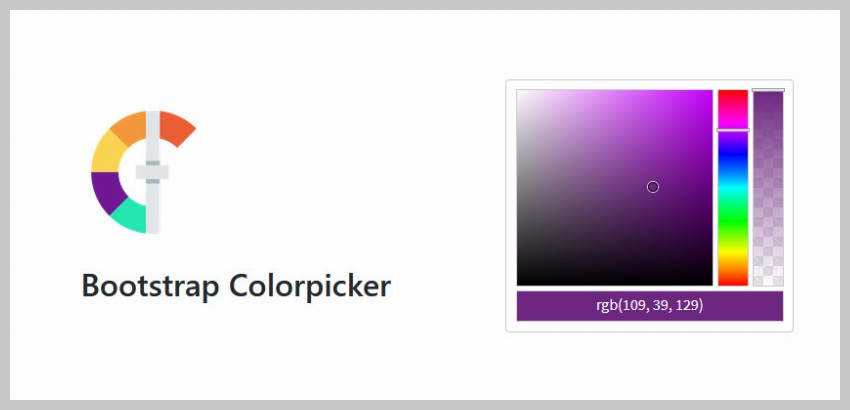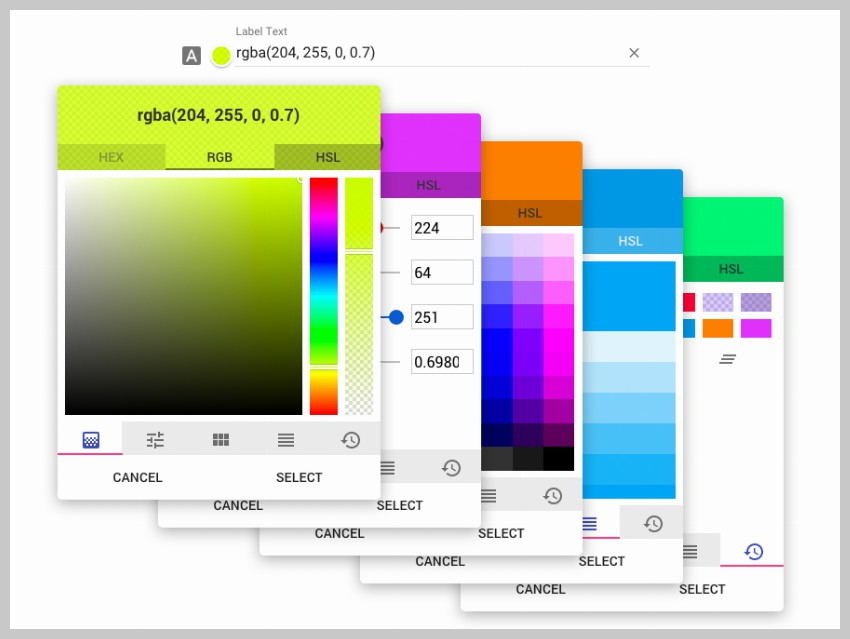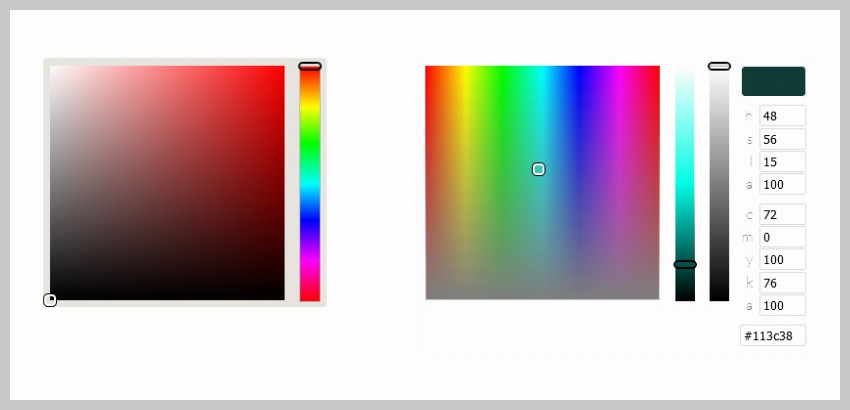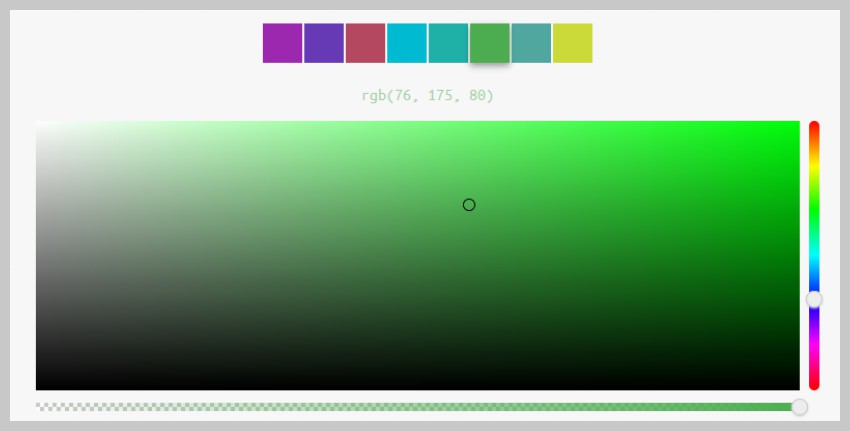Color pickers are complex UI elements that allow the user to select a color from a given palette. There are two ways to add a color picker to a web page. The first involves simply using an input element and setting the type attribute to color. It's easy to add and you can attach event listeners to make any changes to the web page based on the selected color.
One problem with using the input element to create a color picker is that the UI can vary significantly across browsers. This may not always be satisfactory depending on what you are trying to create. Your users usually expect to see only minor changes in the UI, no matter what browser they use. Additionally, the visual appearance of the built-in color picker may not blend properly with the overall theme of your site.
You can solve this problem with the help of a JavaScript-based color picker. In this article, I’ll introduce you to some of the best free and open-source JavaScript color pickers that come with their own unique features and UI.
Huebee Color Picker
Huebee Color Picker provides you with a user-friendly interface for displaying a limited set of colors. Typically, color pickers ask you to select a color from a gradient from one point to the next. Huebee, on the other hand, displays a specific set of colors based on parameters you set.
The color picker's initialization option allows you to specify the number of hues to be included in the color picker. You can also choose the amount of hue and saturation, as well as the first hue of the color grid. There's even an option to display your own set of custom colors in the color picker by passing them as an array.
Additionally, Huebee has an event listener that allows you to take action when the selected color value changes. You can use four different properties to individually access the full color value or its hue, saturation, and brightness. You can also use the isLight property to check if the user has selected a light or dark color.
Other features of the Huebee color picker are documented on the official website.
Bootstrap Color Picker
As you may have guessed, Bootstrap Colorpicker is a color picker plugin for Bootstrap. It comes in two different versions. The 2.x version works with Bootstrap 3 and 4, while the 3.x version works with Bootstrap 4.

One benefit of the 3.x version is that it still works even if you don't use Bootstrap at all. You can use it without using the Bootstrap framework simply by setting the value of the popover option to false or null during initialization.
You can do a lot of interesting things with this library. For example, you can create a predefined color palette to display to users along with a color picker. You can also create a more advanced color picker that will create dynamic color swatches based on your currently selected color.
You have a lot of control over the color picker's UI. This includes everything from making subtle changes to its appearance to adding entirely new elements, such as buttons using your own HTML template. The documentation on the website covers all of this in more detail.
Reaction Color
Websites and applications use several different types of UI to select colors. Have you ever wanted to try any of these on your website? The React Color library lets you do just that.

It comes with 13 different pre-built color pickers to simulate the UI of popular websites and applications like GitHub, Photoshop, Chrome, and Twitter. Not only that, you can also use different components to create your own unique color picker.
MD Color Picker
MD Color Picker is actually an Angular-based color picker, and its UI is inspired by the Material Design philosophy. It also uses a small library called tinycolor.js to manipulate color values.

The color picker provides users with many different ways to select colors from pop-ups. They can use the good old RGB spectrum or use the RGBA slider. They can also choose their preferred color using two different palette variations. You can add an optional feature to track users' past color choices to help them choose colors quickly.
Color Joe
Colorjoe is a simple and extensible color picker that you can easily integrate into your website. The term “scalable” here refers to your ability to use CSS to define dimensions and control layout so that it looks great on all screen sizes.

It comes with two different event listeners - change and done - to help you react based on user interaction with the color picker. Passing a bunch of parameters during initialization allows you to create an RGB or HSL selector. The API also makes it easier to add your own UI elements to the color picker to customize it to your needs.
iris
Iris is a simple color picker created by Automattic, the company behind WordPress. It uses jQuery and jQuery UI as dependencies, so it's a good choice for anyone already using these two libraries. After including the relevant library, you can integrate the color picker into your own website by calling iris() on the input element.
There are many useful options you can set to change how the color picker behaves on your site. You can display a palette of common colors or pass an array of colors to display in a palette. You have full control over the width of the color picker and where it pops up when attached to an input element.
Iris also has some callback functions and methods, you can learn about them on the Iris website. It includes some live working examples of the color picker.
Radial Color Picker
This radial color picker takes a different approach to the UI aspect of color pickers. It comes with a radial slider that displays the selected color in its center. Our goal is to be as simple and easy to use as possible.
Check out the following demo by Rosen to learn how to use color pickers in Vue.js:
Keeping this idea in mind, the slider provides support for screen readers and keyboard-based color selection. You can press the Up and Down arrow keys to increase or decrease the tonal value. The user can close or open the color picker by pressing the Enter key, and then press the Tab key to bring the color picker into focus.
Saturation and brightness values ??are passed to the color picker during initial setup. For more information about the different configuration options for the color picker, visit the Radial Color Picker website.
I've linked to the Vue version, but this color picker also works with React and Angular.
ColoReact
ColoReact Color Picker is another small color picker widget that works well with React. It's easy to use and allows you to create color pickers of varying complexity. The UI will respond in all these situations.

The examples page explains how to create a very basic color picker or create something that supports transparency and color swatches. You can also create a custom UI for the color picker that blends perfectly with your website.
Selection of color
ColorPick library is a simple jQuery plugin that you can add to your website to integrate a minimal color picker with a modern look. It has a very stylish design that blends seamlessly with almost any website.

Since this is a jQuery plugin, you will need to include the jQuery library in your web page if you haven't already done so. Two nice features of this color picker are its dark mode and the ability to automatically save recently selected colors to local storage.
The color picker uses the Flat UI color database by default. However, you can also provide your own color set and change the palette's labels during initialization.
You may have noticed that this color picker provides the user with a relatively small list of colors to choose from. It compensates for this by giving you the option to include an input element and its allowCustomColor parameter, where the user can enter a hexadecimal value for any color they like.
Iro.js
iro.js Color Picker is the most feature-rich JavaScript color picker widget on our list. The fact that it doesn't have any other dependencies makes it even more attractive. You don't need to load any third-party libraries or frameworks or any CSS or image files for the color picker to work. Check out this pen by James Daniel:
Some of its features include the ability to handle hexadecimal, RGB, HSV and HSL color values ??using a single API. The widget also comes with its own set of pre-built UI components. If you are trying to create a color scheme for any new design or product, you can even choose multiple colors from the same color picker widget.
There are a number of initialization options available to determine the behavior and appearance of the color picker. All of this is explained in detail in the widget's documentation. You'll also find some advanced usage examples of color pickers there.
Final Thoughts
Color pickers are very useful UI elements, but difficult to recreate from scratch. That’s why I wanted to write this article to provide you with a list of the best free and open source JavaScript color pickers you can use in your projects. I tried to cover all the bases here by including dependency-free color pickers as well as those that work with other popular libraries or frameworks like Bootstrap, jQuery, Angular, Vue, and React.
Hopefully one of these color pickers has the functionality you need, but if not, there are many more color pickers available on GitHub to discover.
The above is the detailed content of Top 10 Free and Open Source JavaScript Color Pickers. For more information, please follow other related articles on the PHP Chinese website!

Hot AI Tools

Undress AI Tool
Undress images for free

Undresser.AI Undress
AI-powered app for creating realistic nude photos

AI Clothes Remover
Online AI tool for removing clothes from photos.

Clothoff.io
AI clothes remover

Video Face Swap
Swap faces in any video effortlessly with our completely free AI face swap tool!

Hot Article

Hot Tools

Notepad++7.3.1
Easy-to-use and free code editor

SublimeText3 Chinese version
Chinese version, very easy to use

Zend Studio 13.0.1
Powerful PHP integrated development environment

Dreamweaver CS6
Visual web development tools

SublimeText3 Mac version
God-level code editing software (SublimeText3)
 How to diagnose high CPU usage caused by WordPress
Jul 06, 2025 am 12:08 AM
How to diagnose high CPU usage caused by WordPress
Jul 06, 2025 am 12:08 AM
The main reasons why WordPress causes the surge in server CPU usage include plug-in problems, inefficient database query, poor quality of theme code, or surge in traffic. 1. First, confirm whether it is a high load caused by WordPress through top, htop or control panel tools; 2. Enter troubleshooting mode to gradually enable plug-ins to troubleshoot performance bottlenecks, use QueryMonitor to analyze the plug-in execution and delete or replace inefficient plug-ins; 3. Install cache plug-ins, clean up redundant data, analyze slow query logs to optimize the database; 4. Check whether the topic has problems such as overloading content, complex queries, or lack of caching mechanisms. It is recommended to use standard topic tests to compare and optimize the code logic. Follow the above steps to check and solve the location and solve the problem one by one.
 How to minify JavaScript files in WordPress
Jul 07, 2025 am 01:11 AM
How to minify JavaScript files in WordPress
Jul 07, 2025 am 01:11 AM
Miniving JavaScript files can improve WordPress website loading speed by removing blanks, comments, and useless code. 1. Use cache plug-ins that support merge compression, such as W3TotalCache, enable and select compression mode in the "Minify" option; 2. Use a dedicated compression plug-in such as FastVelocityMinify to provide more granular control; 3. Manually compress JS files and upload them through FTP, suitable for users familiar with development tools. Note that some themes or plug-in scripts may conflict with the compression function, and you need to thoroughly test the website functions after activation.
 How to optimize WordPress without plugins
Jul 05, 2025 am 12:01 AM
How to optimize WordPress without plugins
Jul 05, 2025 am 12:01 AM
Methods to optimize WordPress sites that do not rely on plug-ins include: 1. Use lightweight themes, such as Astra or GeneratePress, to avoid pile-up themes; 2. Manually compress and merge CSS and JS files to reduce HTTP requests; 3. Optimize images before uploading, use WebP format and control file size; 4. Configure.htaccess to enable browser cache, and connect to CDN to improve static resource loading speed; 5. Limit article revisions and regularly clean database redundant data.
 How to prevent comment spam programmatically
Jul 08, 2025 am 12:04 AM
How to prevent comment spam programmatically
Jul 08, 2025 am 12:04 AM
The most effective way to prevent comment spam is to automatically identify and intercept it through programmatic means. 1. Use verification code mechanisms (such as Googler CAPTCHA or hCaptcha) to effectively distinguish between humans and robots, especially suitable for public websites; 2. Set hidden fields (Honeypot technology), and use robots to automatically fill in features to identify spam comments without affecting user experience; 3. Check the blacklist of comment content keywords, filter spam information through sensitive word matching, and pay attention to avoid misjudgment; 4. Judge the frequency and source IP of comments, limit the number of submissions per unit time and establish a blacklist; 5. Use third-party anti-spam services (such as Akismet, Cloudflare) to improve identification accuracy. Can be based on the website
 How to use the Transients API for caching
Jul 05, 2025 am 12:05 AM
How to use the Transients API for caching
Jul 05, 2025 am 12:05 AM
TransientsAPI is a built-in tool in WordPress for temporarily storing automatic expiration data. Its core functions are set_transient, get_transient and delete_transient. Compared with OptionsAPI, transients supports setting time of survival (TTL), which is suitable for scenarios such as cache API request results and complex computing data. When using it, you need to pay attention to the uniqueness of key naming and namespace, cache "lazy deletion" mechanism, and the issue that may not last in the object cache environment. Typical application scenarios include reducing external request frequency, controlling code execution rhythm, and improving page loading performance.
 How to enqueue assets for a Gutenberg block
Jul 09, 2025 am 12:14 AM
How to enqueue assets for a Gutenberg block
Jul 09, 2025 am 12:14 AM
When developing Gutenberg blocks, the correct method of enqueue assets includes: 1. Use register_block_type to specify the paths of editor_script, editor_style and style; 2. Register resources through wp_register_script and wp_register_style in functions.php or plug-in, and set the correct dependencies and versions; 3. Configure the build tool to output the appropriate module format and ensure that the path is consistent; 4. Control the loading logic of the front-end style through add_theme_support or enqueue_block_assets to ensure that the loading logic of the front-end style is ensured.
 How to add custom fields to users
Jul 06, 2025 am 12:18 AM
How to add custom fields to users
Jul 06, 2025 am 12:18 AM
To add custom user fields, you need to select the extension method according to the platform and pay attention to data verification and permission control. Common practices include: 1. Use additional tables or key-value pairs of the database to store information; 2. Add input boxes to the front end and integrate with the back end; 3. Constrain format checks and access permissions for sensitive data; 4. Update interfaces and templates to support new field display and editing, while taking into account mobile adaptation and user experience.
 How to add custom rewrite rules
Jul 08, 2025 am 12:11 AM
How to add custom rewrite rules
Jul 08, 2025 am 12:11 AM
The key to adding custom rewrite rules in WordPress is to use the add_rewrite_rule function and make sure the rules take effect correctly. 1. Use add_rewrite_rule to register the rule, the format is add_rewrite_rule($regex,$redirect,$after), where $regex is a regular expression matching URL, $redirect specifies the actual query, and $after controls the rule location; 2. Custom query variables need to be added through add_filter; 3. After modification, the fixed link settings must be refreshed; 4. It is recommended to place the rule in 'top' to avoid conflicts; 5. You can use the plug-in to view the current rule for convenience






